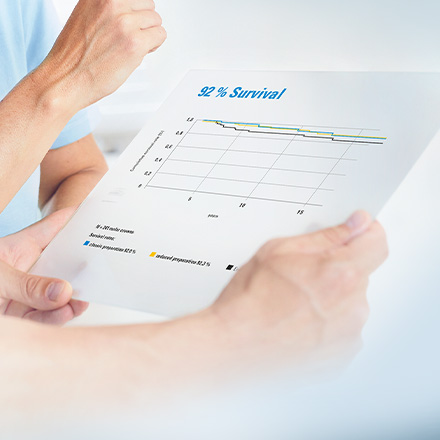Monolithic restorations from blanks with an integrated shade gradient are becoming more and more popular. It's no wonder: these blocks and discs make life far easier for users as they fundamentally replicate the natural shade effect of dentition. This saves time and streamlines workflows. Users can focus more on morphology and texture, and even in the anterior region, create patient appropriate restorations with little or no characterization. For the patient, the veneer-free restoration means a reduced risk of chipping or fracture.
Monolithic and polychromatic: VITABLOCS are the latest trend
Proven and ahead of its time
The proven feldspar ceramic VITABLOCS TriLuxe forte with a shade transition from the cervical area to the incisal edge has already been aligned with this current trend since 2007. Just three years later, VITABLOCS RealLife completed the polychromatic VITABLOCS portfolio with a three-dimensional, curved shade gradient between the dentin area and incisal edge [1]. In addition to integrated esthetics, both variants also impress with a variety of benefits for monolithic restorations:
Shade accuracy in line with VITA shade standards
The basis for successful monolithic restoration is the shade accuracy of the blank in line with the VITA shade standards. This is the only way that a block in the appropriate shade can be selected after tooth shade determination. VITABLOCS offer proven shade accuracy – just choosing the right block means the shade is right too [2, 3]. The portfolio in the two shade standards, VITA classical A1 – D4 and the VITA SYSTEM 3D-MASTER, offers the necessary range to find the blank with the right shade for every patient.
Appearance similar to natural dentition
It's not just the shade that has to be right – the translucence and the play of light in the restoration must replicate natural dentition in order for a monolithic restoration to be successful. Generally, all VITABLOCS blanks are made of a natural raw material called feldspar and offer optical properties similar to those of natural dentition [4]. That's why the polychromatic variants of VITABLOCS in particular, are ideal for highly esthetic single-tooth anterior restorations from a single cast.
Easy to polish
Achieving smooth surfaces when finishing is essential for monolithic surfaces. This is the only way to protect the antagonist and the restoration itself against excessive abrasion in long-term clinical outcomes. VITABLOCS blanks are comprised of a finely structured feldspar ceramic that is proven to facilitate rapid and simple polishing [5, 6]. What's more: VITABLOCS restorations can be seated immediately after finishing and polishing. Glaze firing is not required.
Abrasion similar to enamel
In long-term clinical outcomes, harmonious abrasion behavior is desirable between the restoration and the antagonist dentition. If the monolithic restoration abrades more slowly than the enamel, premature contacts occur automatically that can result in parafunction. If the restoration abrades too fast, this puts the long-term success of the restoration at risk. VITABLOCS feature abrasion similar to that of enamel [7], which facilitates proper occlusion and durability.
High success and survival rate
In long-term clinical outcomes, monolithic single-tooth restorations made from VITABLOCS show a high success rate and rate of survival, even in the posterior area that is subject to greater wear [8, 9]. Likewise, in clinical studies, veneers [10] and anterior crowns [11] made from feldspar ceramic demonstrated high reliability as expected. This robustness in combination with the natural esthetics of the polychromatic VITABLOCS variants is your guarantee for successful monolithic results.
Are you interested? Click here and find out more:
- [1] Kurbad A. Three-dimensionally layered ceramic blocks. Int J Comput Dent. 2010;13(4):351-65. English, German. Erratum in: Int J Comput Dent 2011; 14(1): 54.
- [2] Aldosari LI, Alshadidi AA, Porwal A, Al Ahmari NM, Al Moaleem MM, Suhluli AM, Shariff M, Shami AO. Surface roughness and color measurements of glazed or polished hybrid, feldspathic and Zirconia CAD/CAM restorative materials after hot and cold coffee immersion. BMC Oral Health 2021 Aug 30; 21(1): 422.
- [3] Moaleem MMA, AlSanosy R, Ahmari NMA, Shariff M, Alshadidi AA, Alhazmi HA, Khalid A. Effects of Khat on Surface Roughness and Color of Feldspathic and Zirconia Porcelain Materials under Simulated Oral Cavity Conditions. Medicina (Kaunas) 2020 May 13; 56(5): 234.
- [4] Masek R. Reproducing natural color effects on milled ceramic restorations. Int J Comput Dent 1999 Jul; 2(3): 209-17.
- [5] Contreras LPC, Dal Piva A, Ribeiro FC, Anami LC, Camargo SEA, Jorge AOC, Bottino MA. Effects of Manufacturing and Finishing Techniques of Feldspathic Ceramics on Surface Topography, Biofilm Formation, and Cell Viability for Human Gingival Fibroblasts. Oper Dent 2018 Nov/Dec; 43(6): 593-601.
- [6] Sarikaya I, Güler AU. Effects of different polishing techniques on the surface roughness of dental porcelains. J Appl Oral Sci 2010 Jan-Feb; 18(1): 10-6.
- [7] Passos SP, de Freitas AP, Iorgovan G, Rizkalla AS, Santos MJ, Santos Júnior GC. Enamel wear opposing different surface conditions of different CAD/CAM ceramics. Quintessence Int 2013 Nov-Dec; 44(10): 743-51.
- [8] Goryainova KE, Apresyan SV, Lebedenko IY, Voronov IA. Sravnitel'naia klinicheskaia otsenka kachestva ortopedicheskogo lecheniia moliarov CAD/CAM koronkami metodikoĭ chairside [Comparative clinical evaluation of the prosthetic treatment quality of molars restored by chairside manufactured CAD/CAM crowns]. Stomatologiia (Mosk). 2019; 98(5): 72-77.
- [9] Otto T. Up to 27-years clinical long-term results of chairside Cerec 1 CAD/CAM inlays and onlays. Int J Comput Dent 2017; 20(3): 315-329.
- [10] Morimoto S, Albanesi RB, Sesma N, Agra CM, Braga MM. Main Clinical Outcomes of Feldspathic Porcelain and Glass-Ceramic Laminate Veneers: A Systematic Review and Meta-Analysis of Survival and Complication Rates. Int J Prosthodont 2016 Jan-Feb; 29(1): 38-49.
- [11] Wiedhahn K, CEREC Veneers: Esthetics and Longevity. In Mörmann WH (ed.) State of the Art of CAD/CAM Restorations, 20 Years of CEREC, Berlin: Quintessence, 2006: 101–112.



